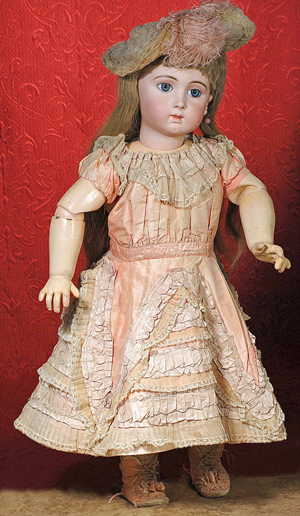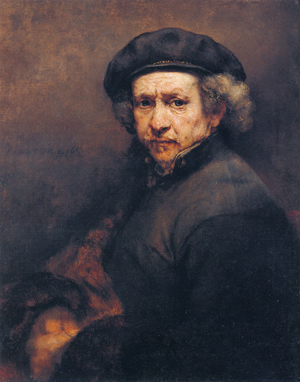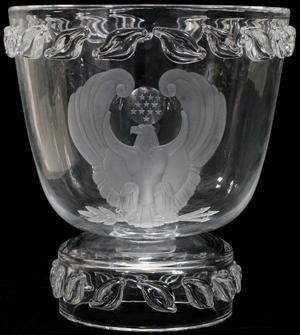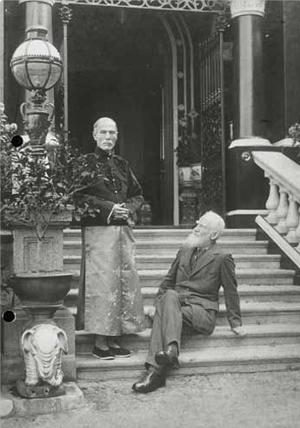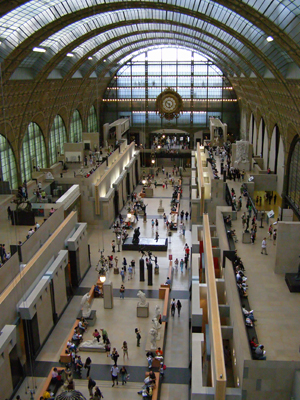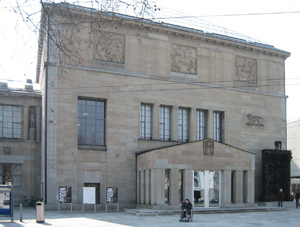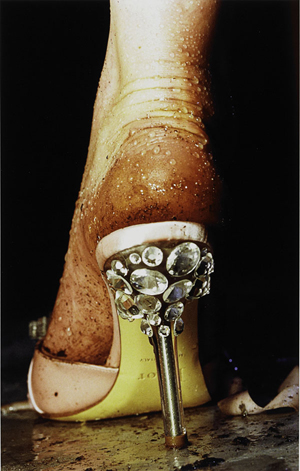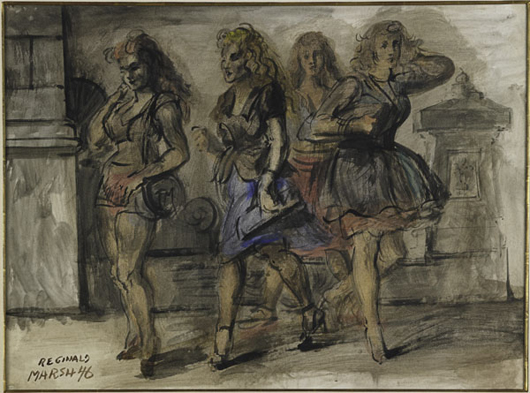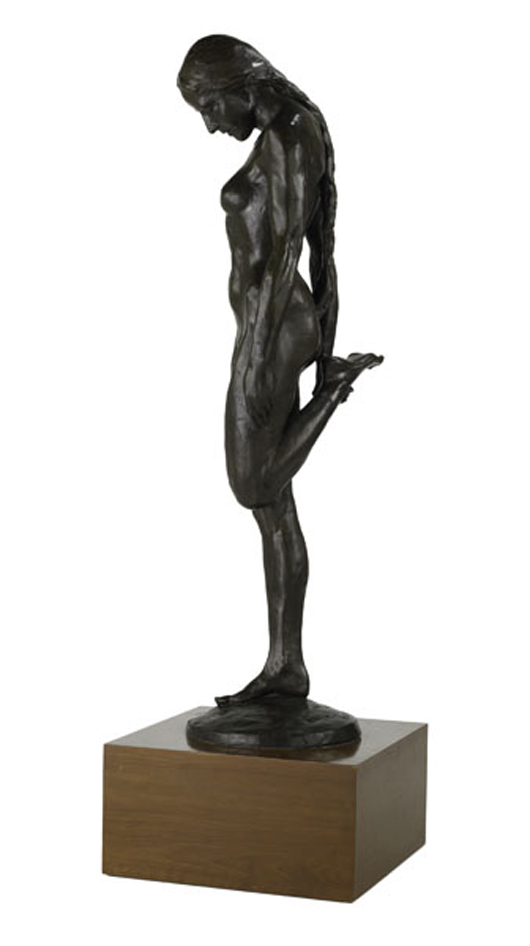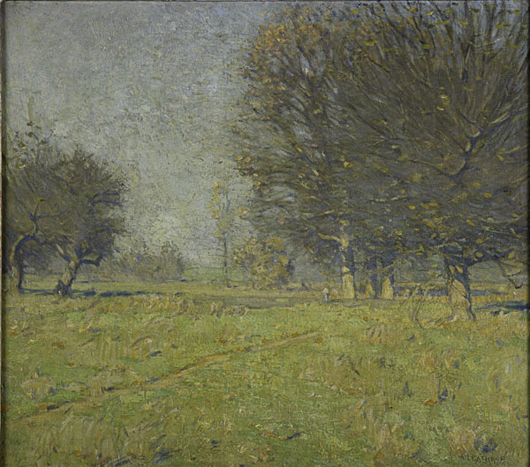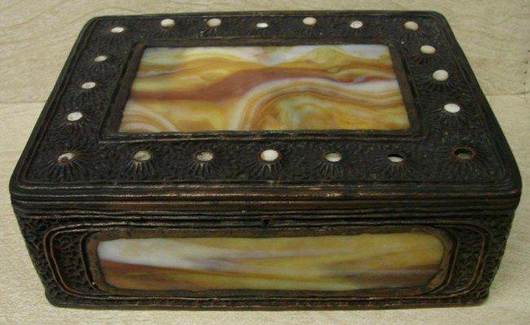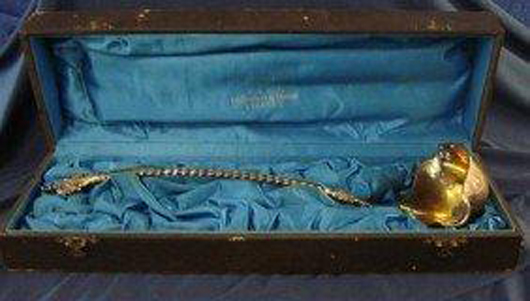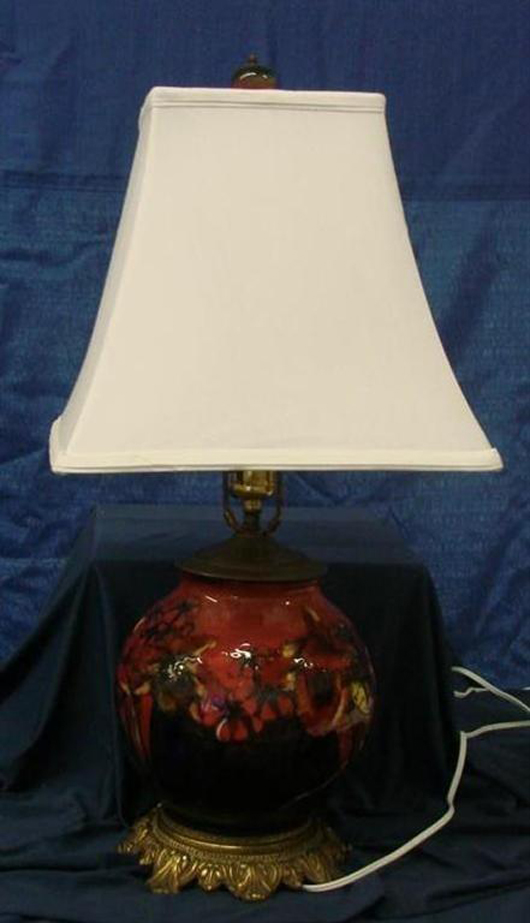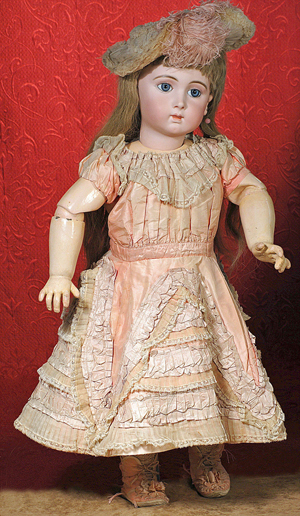
Magnificent 29-inch size 13 ‘Triste bebe’ by Jumeau with luminous complexion. Image courtesy Frasher’s Doll Auctions.
KANSAS CITY, Mo. – Splendidly attired French bebes and poupees will make a fashion statement at Frasher’s auction Nov. 5, which is appropriately titled “A Shopping Spree – For Bebe & Me.” The event will be held at the KCI Expo Center at Kansas City International Airport.
Online live bidding for the 300-lot auction will be facilitated by LiveAuctioneers.com.
Although dolls dressed in the finest fashions of their era adorn the catalog pages, more luscious frocks, bonnets, parasols and finery are waiting to be purchased.
Preview for the sale will be Saturday, Nov. 5, from 9 until the start of the sale at 10:30 a.m. Central. On Sunday, Nov. 6, Frasher’s will conduct an uncataloged auction, for attending bidders only, featuring over 275 lots.
The auction is based on a fine private collection focused primarily on choice French dolls and fabulous doll clothing, bonnets, parasols and assorted accessories and miniatures, plus dolls from the Reber estate.
The luscious Bebe Bru Jne 7 with entrancing blue eyes and fitted French silk costume leads the French parade accompanied by bebes by Petit & Dumontier, Jumeau, Steiner, Delcroix and other French firms.
Jumeau is especially well represented throughout the catalog pages which include the rare size 1 bebe with cartouche mark, early portrait models, E.J. Bebe with earliest mark, lovely blue-eyed bebe with incised depose mark, and the delectable size 13 Bebe Triste, as well as other examples by Jumeau.
From Steiner is an impressive array of bebes beginning with the tiny size 1 “Series A” bebe as well as a grand 32-inch Figure A, and 28-inch Series C bebe, all with luxurious antique or couturier costuming.
French poupees are notable for quality and costuming, ranging from the petite 12-inch example by Bru to the superb 24-inch and 28-inch models attired in their most fashionable gowns. Rare models of note are the 14-inch poupee with blown leather body, 18-inch wood-bodied poupee by Barrious as well as 24-inch Barrois with Celment & Dehors neck articulation.
A fine group of 18th-century carved English wooden dolls include Queen Anne examples in sizes 13, 14 and 20 inches. From the 19th century are several Neapolitan figures with an especially fine 24-inch model in jeweled robe grabbing the spotlight.
German dolls are highlighted by an outstanding 38-inch Handwerck child coming from her original home, Kammer and Reinhardt character models #101 and #114, other cabinet-size dolly faces, plus French-type Belton and Sonneberg dolls, as well as character babies, and all-bisque dolls.
From the Reber estate is a collection of Schoenhut models, many from the earliest period, with the seldom-found model 106 carved-bonnet girl claiming the title of most rare. Other Schoenhuts include #100 girl with carved pageboy hairstyle, several examples of braided-hair girls #102, plus models, 101, 204, 308 and other desirable examples.
Collectors of cloth dolls will appreciate the circa 1930s Lenci dolls and the more than 30 models of the R. John Wright cloth characters beginning with his earliest works and continuing to the present era. There are dollhouses by Albin Schonherr and Gottschalck featuring colorful lithography, plus dollhouse miniatures, several items of French gilded bronze enamelware, Beidermeier furniture, assortment of French Brittany furnishings, Marklin doll carriage, three carved Swiss wooden dolls.
Collectors will marvel at the abundance of fine dresses, bonnets, parasols including Huret, purses, jewelry, vitrines, gloves, fans, muff, miniatures and other luxury items.
A color catalog for this auction is available with estimates and after-sale prices realized. The auction can also be viewed on liveauctioneers.com approximately three weeks prior to the auction. This will be a wonderful weekend for doll collectors plus an opportunity to view and acquire beautiful dolls and accessories.
A beautiful 80-page catalog is available for $43. For information or to order a catalog contact Frasher’s Doll Auctions, 2323 S. Mecklin School Road, Oak Grove, MO 64075; email Frasher@aol.co or phone 816-625-3786.
ADDITIONAL LOTS OF NOTE
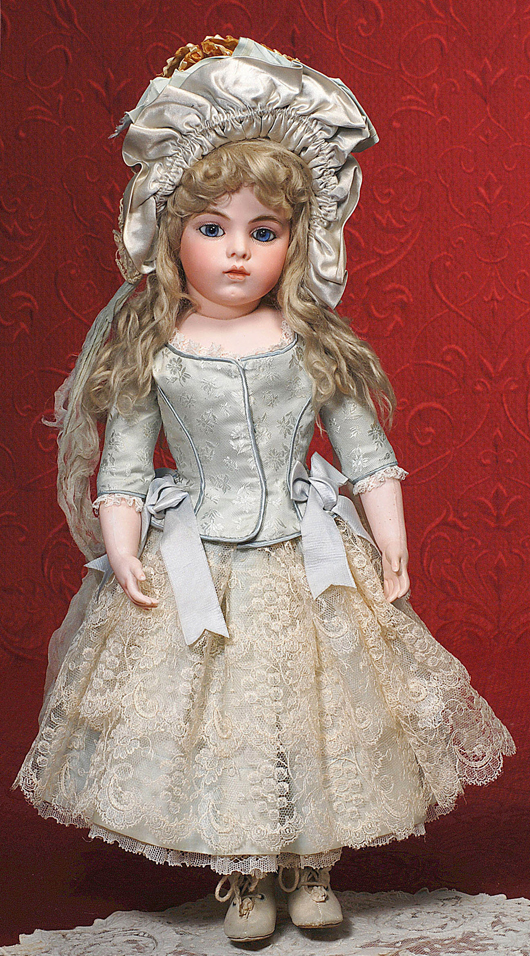
Jumeau Bebe known as ‘Portrait’ – early model with original boutique label in antique costume. Image courtesy Frasher’s Doll Auctions. 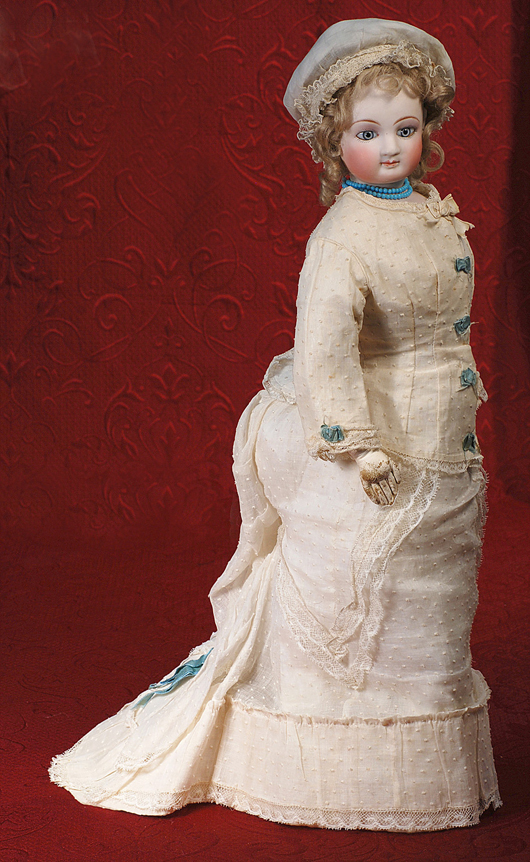
Twenty-four-inch French poupee with rare Dehors neck articulation by E. Barrios for Simmone. Image courtesy Frasher’s Doll Auctions. 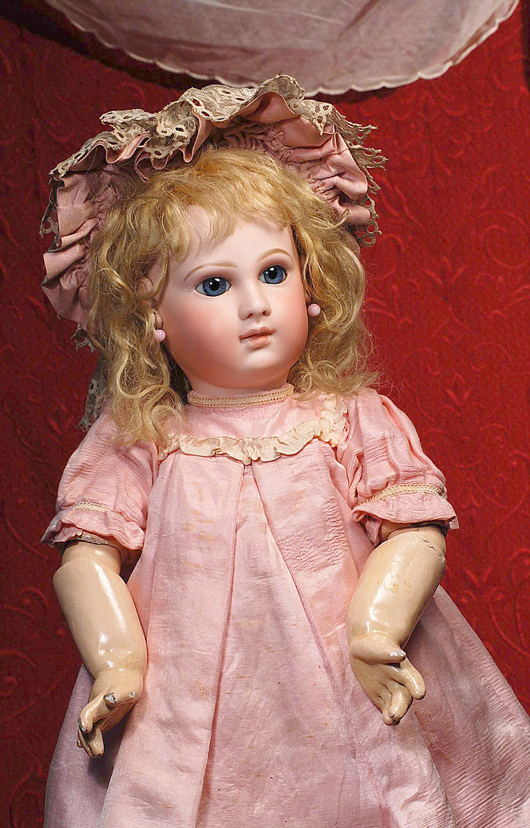
Alluring 20-inch Bru Jne Bebe with pale bisque and deep blue paperweight eyes. Image courtesy Frasher’s Doll Auctions. 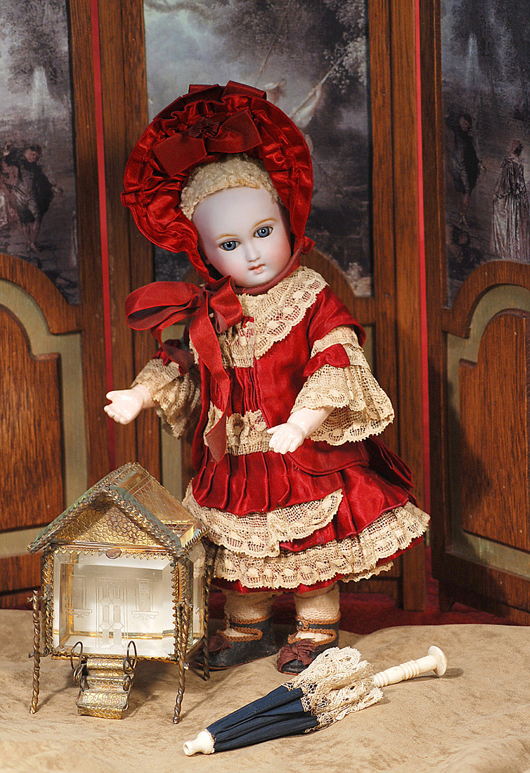
Size 1 Jumeau Bebe with cartouche incised mark in a red silk couturier costume and signed shoes stands aside a fine French glass dollhouse and ivory-handled parasol. Image courtesy Frasher’s Doll Auctions. 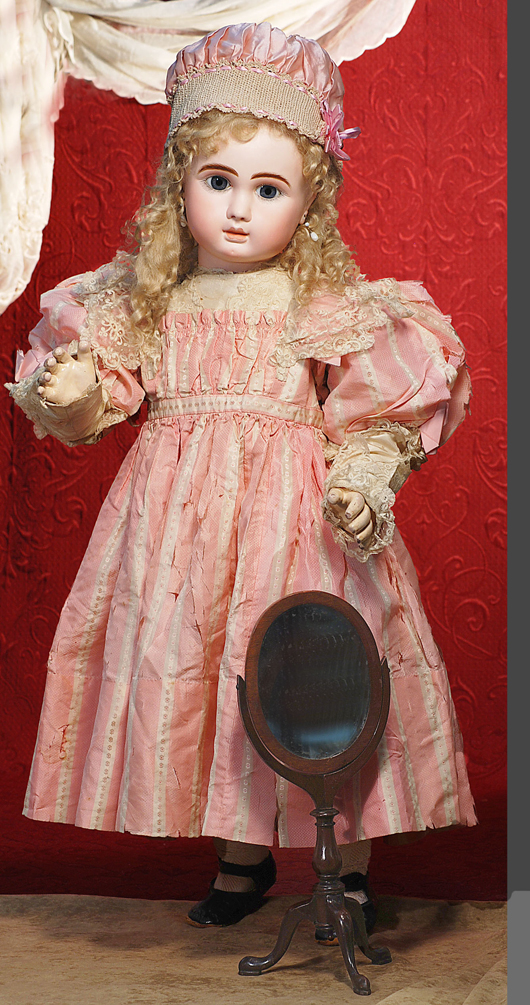
Thirty-two-inch grand size of the Steiner ‘Figure A’ bebe with wire-lever eyes and silk couturier frock. Image courtesy Frasher’s Doll Auctions.


